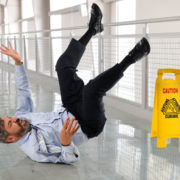Three Ways to Think About Workplace Safety
According to an analysis by Liberty Mutual, the two most expensive causes of workplace injury are overexertion and falls. These two things alone cost employers nearly 23 and a half BILLION dollars last year. But that’s not the only reason to think about raising your workplace safety game.
Workplace safety is a concern for many people on a variety of levels. Employees expect to be provided with a safe place to work. Customers expect to have a safe experience in the places they frequent. Banks and insurance companies want to work with companies that aren’t being unnecessarily risky. And business owners have a whole other set of worries:
- What happens if an employee gets hurt?
- Who will cover shifts if an injury causes someone to be out for an extended time?
- How will an accident affect our operating costs? Healthcare? Business insurance?
- What about expensive fines, penalties and litigation?
- Are we even in compliance?
- How can we protect our employees and ourselves?
These are all very valid questions and concerns. Let’s talk about how to keep your company and everyone in it as safe as possible.
1. Think big
Safety is about more than just checking the boxes required to comply with Federal and local regulations. If your company is doing the bare minimum to meet workplace safety requirements, you’re going to get the bare minimum when it comes to results.
If you really want to put safety to work for you and your business, you need to think bigger. Create a culture of workplaces safety. Don’t just make it a priority, commit to making it one of your core values. Weave it into your infrastructure, your operations, and your daily reality.
Here are a few quick ways to get started:
- Make time for it. Move safety to the top of your to do list and keep it top of mind.
- Include workplace safety as a critical part of all business decision-making processes.
- Train staff and leadership thoroughly from a safety-first perspective.
- Communicate about safety openly and often.
- Put your money where your mouth is. Invest in a safer workplace.
There’s a big difference between talking about safety and actively working to create a safe environment. Employees can tell the difference between an employer who says they care about safety and one who truly does. Be on the right side of that equation.
2. Think small
While you’re building your strong foundation for safe practices, don’t be tempted to let the little things slide. When it comes to workplace safety, little things matter. Workplace safety often lies in the details, where little things can become big things in an instant.
A loose cord, a slippery floor, or a cracked pair of safety glasses may not seem like a big deal, but in the wrong set of circumstances, it could be.
If an employee comes to you with a safety concern, no matter how large or small, take it seriously. Better yet, be proactive about finding potential unsafe areas, equipment, and practices. Do a safety audit to determine what tools and processes need to be fixed, replaced, or thrown out entirely.
Not only will this keep your workplace safe and your business protected, it will show your employees that you care enough to invest in their wellbeing.
3. Think smart
Everyone wants to work in a safe environment. That’s a no-brainer. So how come so many businesses don’t do what it takes to actually get there?
Perhaps they think that fully committing to workplace safety sounds way too:
- expensive
- complicated
- time consuming
- unnecessary
- paranoid
If you’ve run into some or all of these objections at your company, now is the time to refer back to the Liberty Mutual study, which found that disabling workplace injuries cost employers over $55 BILLION dollars last year. That’s right. Billion. With a B. Now which strategy sounds more expensive?
Focusing on workplace safety is smart business. It’s not just good for the health of your employees. It’s good for the health of your organization. And that’s good for everyone.
Content provided by Q4iNetwork and partners
Photo by Michael Simons
![]()










